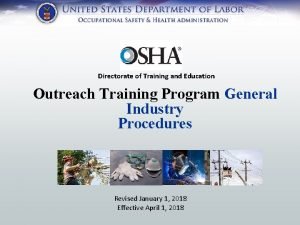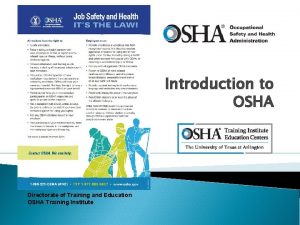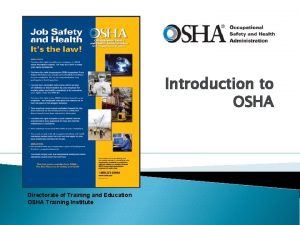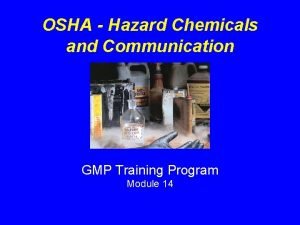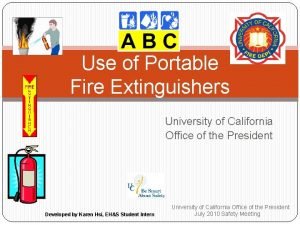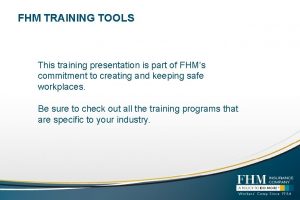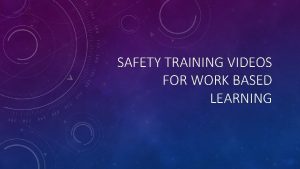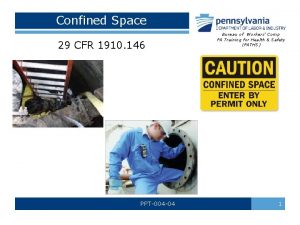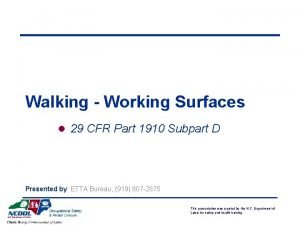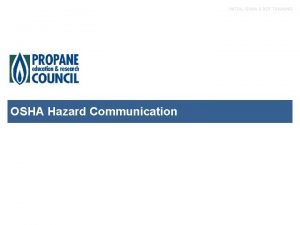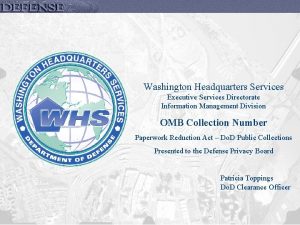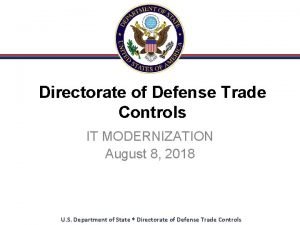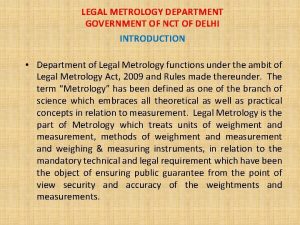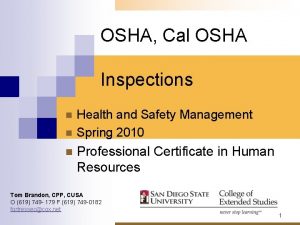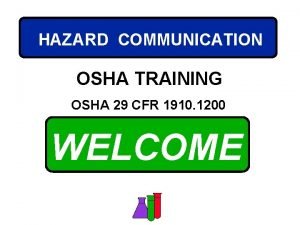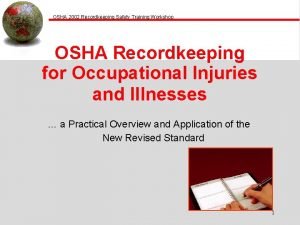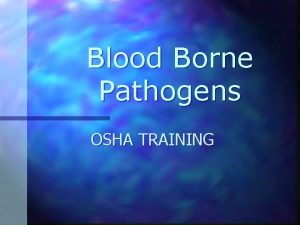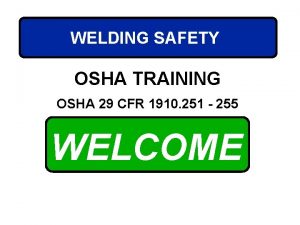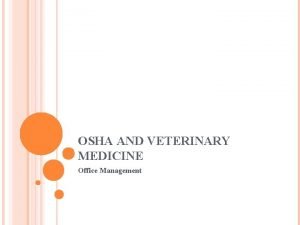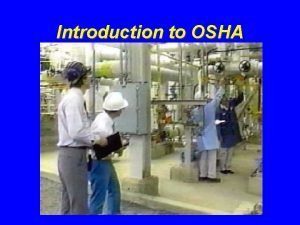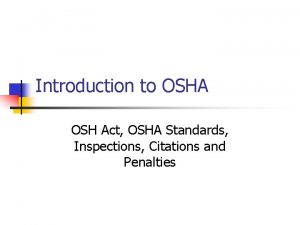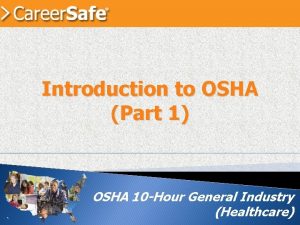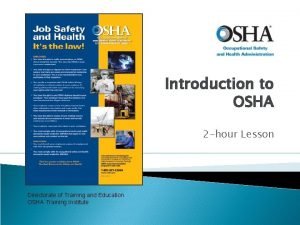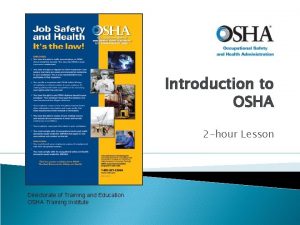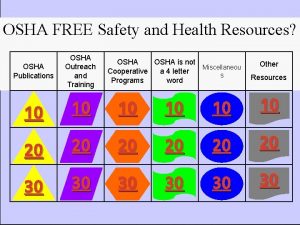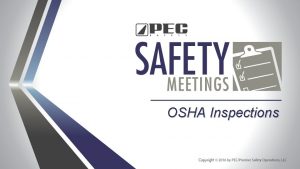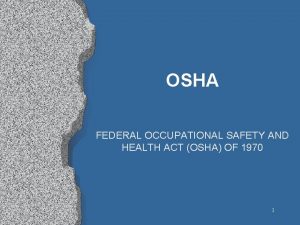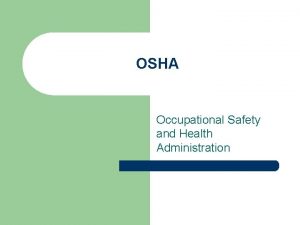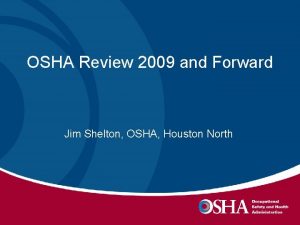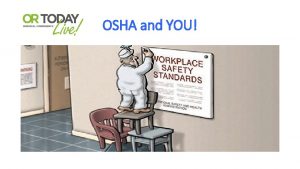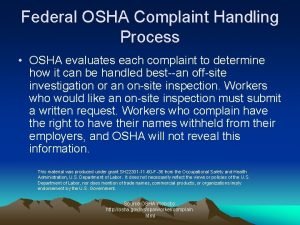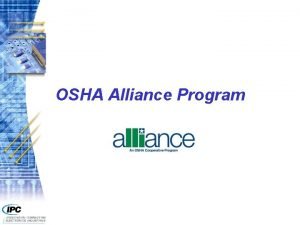Introduction to OSHA Directorate of Training and Education






































- Slides: 38

Introduction to OSHA Directorate of Training and Education OSHA Training Institute

Lesson Objectives Purpose: To provide workers with introductory information about OSHA After completing this lesson, you will be able to. . . 1. Explain why OSHA is important to workers 2. Explain workers rights under OSHA 3. Discuss employer responsibilities under OSHA

Intro to OSHA http: //www. bing. com/videos/search? q=intro+to+osha&FORM=HDRSC 3#view=detail&mid=562977 DDD 3 DF 897636 DD 3

Topic 1: Why is OSHA Important to You? 4, 585 workers were killed on the job in 2013 An average of nearly 12 workers die every day 797 Hispanic or Latino workers were killed from work-related injuries in 2013 Nearly 3 million serious workplace injuries and illnesses were reported by private industry employers in 2012 OSHA Makes a Difference • On Average, worker deaths in America are down 66%. • 1970 – 38 worker deaths per day • 2013 – 12 worker deaths per day • Worker injuries and illnesses are down. • 1972 – 10. 9 per 100 workers • 2013 – 3. 0 per 100 workers

History of OSHA ◦ Occupational Safety and Health Administration, an agency of the U. S. Department of Labor OSHA’s responsibility is to improve worker safety and health protection On December 29, 1970, President Nixon signed the OSHA Act. This Act created OSHA, the agency, which formally came into being on April 28, 1971

OSHA’s Mission The mission of OSHA is to assure safe and healthful working conditions for working men and women by setting and enforcing standards, and by providing training, outreach, education, and assistance. Some of the things OSHA does to carry out its mission are: ◦ Worksite inspections ◦ Training programs

Federal & State OSHA (the Occupational Safety and Health Administration, which is a federal agency) L&I (the Department of Labor and Industries, which is a state agency) WISHA (the Washington Industrial Safety and Health Act of 1973, which is a state law) - empowers L&I to create and enforce safety and health regulations DOSH (the Division of Occupational Safety and Health, which is part of L&I) – enforces the WISHA law by developing safety and health rules, including inspecting worksites for unsafe working conditions RCW/RCWs stands for the “Revised Code of Washington” http: //www. lni. wa. gov/safety/basics/About/default. asp 7

Temporary Workers Temporary labor continues to be prevalent nationwide. An assessment of workplace injury data performed by the federal Occupational Safety and Health Administration found that temporary employees suffer on-the-job accidents and injuries more often than those who are permanently employed. https: //www. osha. gov/temp_workers/

Brain Check 1. Worker protection is law: True or False? 2. OSHA was created in what year? _______ 3. OSHA stands for _______ 4. It is the duty of the _____ to provide workplaces that are free of known dangers that could harm their employees.

Topic 2: What Rights Do You Have Under OSHA? You have the right to: ◦ A safe and healthful workplace ◦ Know about hazardous chemicals ◦ Report injury to employer ◦ Complain or request hazard correction from employer ◦ Training ◦ Hazard exposure and medical records ◦ File a complaint with OSHA ◦ Participate in an OSHA inspection ◦ Be free from retaliation for exercising safety and health rights

Worker Rights

Your Right to… Know about Hazardous Chemicals Hazard Communication Program Appropriate labeling of chemical containers Safety Data Sheets (SDSs) Worker training v Physical and health hazards of the chemicals, and how workers can protect themselves

Your Right to… Information about Injuries/Illnesses Log of injuries and illnesses Workers have the right to report an injury* and review current log OSHA 300 A *It is against the OSHA law to retaliate or discriminate against a worker for reporting an injury or illness

Your Right to… Hazards in the workplace http: //wn. com/funny_workplace_accident 14

How to Raise a Concern Safety and Health Problems in the Workplace

Your Right to… Training Workers have a right to get training from employers on a variety of health and safety hazards and standards that employers must follow Chemical hazards, equipment hazards, noise, confined spaces, fall hazards in construction, personal protective equipment Language and vocabulary

Your Right to… Complain or Request Corrections Workers may bring up safety and health concerns in the workplace to their employers without fear of discharge or discrimination OSHA rules protect workers who raise concerns to their employer or OSHA about unsafe or unhealthful conditions in the workplace

Your Right to… Examine Exposure & Medical Records 1910. 1020: right to examine & copy records Examples of toxic substances and harmful physical agents are: ◦ Metals and dusts, such as, lead, cadmium, and silica ◦ Biological agents, such as bacteria, viruses, and fungi ◦ Physical stress, such as noise, heat, cold, vibration, repetitive motion, and ionizing and non-ionizing radiation

Your Right to… Participate in an OSHA Inspection Employee representative can accompany OSHA inspector Workers can talk to the inspector privately Workers may point out hazards, describe injuries, illnesses or near misses that resulted from those hazards and describe any concern you have about a safety or health issue Workers can find out about inspection results, abatement measures & may object to dates set for violation to be corrected

Your Right to… File a Complaint with OSHA Workers may file a confidential complaint with OSHA Workers may request that their name not be revealed to the employer If a worker files a complaint, they have the right to find out OSHA’s action on the complaint and request a review if an inspection is not made Note: Often the best and fastest way to get a hazard corrected is to notify your supervisor or employer.

Your Right to… Be Free from Retaliation Workers have the right to be free from retaliation for exercising safety and health rights Workers have a right to seek safety and health on the job without fear of punishment This right is spelled out in Section 11(c) of the OSH Act https: //osha. gov/pls/oshaweb/owadisp. show_document? p_table=STANDARDS&p_id=11333 Workers have 30 days to contact OSHA if they feel they have been punished for exercising their safety and health rights

Topic 3: What Responsibilities does Your Employer have Under OSHA? Provide a workplace free from recognized hazards and comply with OSHA standards Provide training required by OSHA standards Keep records of injuries and illnesses Provide medical exams when required by OSHA standards and provide workers access to their exposure and medical records Not discriminate against workers who exercise their rights under the Act (Section 11(c)) Post OSHA citations and hazard correction notices Provide and pay for most PPE

Employer Responsibilities (cont. ) REPORTING AND RECORDING CHECKLIST Employers must: ü Report each worker death to OSHA ü Report each work-related hospitalization, amputation, or loss of an eye ü Maintain injury & illness records ü Inform workers how to report an injury or illness to the employer ü Make records available to workers ü Allow OSHA access to records ü Post annual summary of injuries & illnesses

Topic 4: What are OSHA Standards? OSHA standards are: Rules that describe the methods employers must use to protect employees from hazards Designed to protect workers from a wide range of hazards Four Groups of OSHA Standards General Industry* Construction Maritime Agriculture *General Industry is the set that applies to the largest number of workers and worksites Where there are no specific standards, employers must comply with the General Duty Clause of the OSH Act.

OSHA Standards (cont. ) These standards also: Limit the amount of ◦ hazardous chemicals ◦ noise PPE Require employers to monitor certain hazards and keep records of workplace injuries and illnesses

Before you get hired https: //www. osha. gov/pls/imis/establishment. html 26

Washington State Department - L&I

Topic 5: How are OSHA Inspections Conducted? The OSH Act authorizes OSHA compliance safety and health officers (CSHOs) to conduct workplace inspections at reasonable times OSHA conducts inspections without advance notice, except in rare circumstances (e. g. Imminent Danger) In fact, anyone who tells an employer about an OSHA inspection in advance can receive fines and a jail term

Different Types of OSHA Inspections Imminent danger Fatality or hospitalizations Worker complaints/referrals Targeted inspections—Local Emphasis Program (LEP), National Emphasis Program (NEP), particular hazards or industries Follow-up Inspections 29

Citations & Penalties VIOLATION TYPE PENALTY WILLFUL A violation that the employer intentionally and knowingly commits or a violation that the employer commits with plain indifference to the law. OSHA may propose penalties of up to $70, 000 for each willful violation, with a minimum penalty of $5, 000 for each willful violation. SERIOUS A violation where there is substantial probability that death or serious physical harm could result and that the employer knew, or should have known, of the hazard. There is a mandatory penalty for serious violations which may be up to $7, 000. OTHER-THAN-SERIOUS A violation that has a direct relationship to safety and health, but probably would not cause death or serious physical harm. OSHA may propose a penalty of up to $7, 000 for each other-than-serious violation. REPEATED A violation that is the same or similar to a previous violation. OSHA may propose penalties of up to $70, 000 for each repeated violation.

Questions for Review Give an example of a reason why might OSHA would conduct an inspection at your workplace What are the types of OSHA violations?

Topic 6: Where Can You Go for Help? Sources within the workplace/worksite Sources outside the workplace/worksite How to file an OSHA complaint

Sources within the Workplace/Worksite Employer or supervisor, co-workers and union representatives Safety Data Sheet (SDS) for information on chemicals Labels and warning signs Employee orientation manuals or other training materials Work tasks and procedures instruction

Sources Outside the Workplace/Worksite OSHA website: http: //www. osha. gov and OSHA offices (you can call or write) Compliance Assistance Specialists in the area offices National Institute for Occupational Safety and Health (NIOSH) http: //www. cdc. gov/niosh/ OSHA Training Institute Education Centers Doctors, nurses, other health care providers Public libraries Other local, community-based resources

Filing an OSHA Complaint Download the OSHA complaint form from OSHA’s website File the complaint online ◦ Workers can file a complaint ◦ A worker representative can file a complaint Telephone or visit local regional or area offices to discuss your concerns Complete the form – be specific and include appropriate details OSHA determines if an inspection is necessary Workers do not have to reveal their name

Session Summary This lesson covered: The importance of OSHA, including the history of safety and health regulation leading to the creation of OSHA and OSHA’s mission Worker rights under OSHA Employer responsibilities OSHA standards OSHA inspections Safety and health resources, including how to file a complaint.

Safety Ambassadors Promote and monitor job-site safety 37

Questions for Review Explain why OSHA is important to workers Explain workers rights under OSHA Discuss employer responsibilities under OSHA
 Osha directorate of training and education
Osha directorate of training and education Osha directorate of training and education
Osha directorate of training and education Osha directorate of training and education
Osha directorate of training and education Norwegian directorate for education and training
Norwegian directorate for education and training Early childhood directorate
Early childhood directorate Government of karnataka department of technical education
Government of karnataka department of technical education Osha hazard and ghs training regulation cfr 1910
Osha hazard and ghs training regulation cfr 1910 Dhs science and technology directorate org chart
Dhs science and technology directorate org chart General directorate of animal health and production
General directorate of animal health and production Vetanika
Vetanika Air force research laboratory logo
Air force research laboratory logo Cal osha fire extinguisher requirements
Cal osha fire extinguisher requirements Osha yard tractor training
Osha yard tractor training Osha videos youtube
Osha videos youtube Fire safety training powerpoint
Fire safety training powerpoint Confined space training ppt
Confined space training ppt B13l
B13l Osha hazard communication initial training
Osha hazard communication initial training Executive services directorate
Executive services directorate Veterinary medicines directorate
Veterinary medicines directorate Vehicle technology directorate
Vehicle technology directorate Norwegian directorate of health registration
Norwegian directorate of health registration Dpw fort bliss
Dpw fort bliss Dtcp ap
Dtcp ap European directorate for the quality of medicines
European directorate for the quality of medicines Technology applications ec-12
Technology applications ec-12 Directorate of logistics
Directorate of logistics Directorate of defense trade controls
Directorate of defense trade controls Directorate general for competition
Directorate general for competition Marketed health products directorate
Marketed health products directorate Metrology department delhi
Metrology department delhi Directorate curriculum fet
Directorate curriculum fet Plant protection directorate nepal
Plant protection directorate nepal 399
399 Tea directorate
Tea directorate Directorate general of foreign trade
Directorate general of foreign trade Turkey ministry of finance
Turkey ministry of finance Directorate of oilseeds development
Directorate of oilseeds development Directorate of health services kashmir
Directorate of health services kashmir
